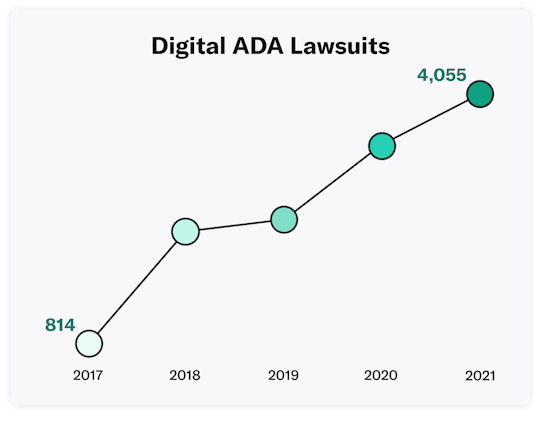ADA Website Accessibility and ADA Compliance Software
When it comes to understanding website accessibility compliance, the law can be confusing, but AudioEye is here to help. Learn about website accessibility compliance standards, the ADA’s regulations on website accessibility, and how AudioEye’s website accessibility software provides fast, secure, sustainable solutions to keep you on the path of compliance and certification while offering superior user experiences.
On This Page
What is the ADA?
The Americans with Disabilities Act (ADA) prohibits discrimination against individuals with disabilities in all areas of public life. It gives millions of individuals with disabilities equal access to all public and private places. The ADA contains five Titles that address specific areas to which the law applies:

Title I – Employment
Ensures equal employment opportunities for individuals with disabilities. Employers (those with at least 15 full-time employees) must provide reasonable accommodations to employees with disabilities to ensure they can participate in the job application process or to perform specific job functions.

Title II – State and Local Government
Prohibits discrimination against individuals with disabilities in all programs, activities and services of public entities. This applies to all state and local governments and any of their departments, agencies or other instrumentalities.

Title III – Businesses
Prohibits discrimination on the basis of disability in places of public accommodation, including such places as restaurants, private schools, sports stadiums, office buildings, and more. Businesses are required to make “reasonable modifications” to serve people with disabilities.

Title IV – Telecommunications
Requires telephone and Internet companies to provide relay services that allow individuals with hearing and speech disabilities to communicate over the telephone.

Title V – Miscellaneous Provisions
Contains provisions relating to the ADA as a whole, including its relationship to other laws, state immunity, its impact on insurance providers and benefits, and so on.
How Title III of the ADA Relates to Website Accessibility
Because the internet as we know it did not exist when the ADA was signed into law, it does not explicitly mention website accessibility. So how does the ADA relate to website accessibility and why are thousands of commercial companies being sued for inaccessible online content
Most lawsuits involve plaintiffs claiming an inaccessible website to be an ADA Title III violation. Title III bans disability discrimination in “places of public accommodation,” and plaintiffs are arguing “places of public accommodation” most certainly include the internet. U.S. Federal Courts are overwhelmingly ruling on the side of accessibility, supporting the notion that, even though the ADA doesn’t specifically mention website or digital accessibility, the internet should be considered a place of public accommodation.
Over the years, these rulings have established legal precedence, including the Domino’s digital accessibility case for which the Supreme Court denied the petition, ultimately reaffirming the lower court’s decision. Businesses with websites can conform (or abide by a set of implicit rules) to Title III by making “reasonable accommodations” for people with disabilities, which may include website features such as:
- Proper Page Title
- Alternative Text for Images
- Correct Color Contrast
- Proper Heading Structure
- Accessible Forms
- Keyboard Access & Visual Focus
ADA Website Accessibility and Its Relation to WCAG
The Web Content Accessibility Guidelines (WCAG), developed by the World Wide Web Consortium (W3C), have become the global standard for website accessibility and the benchmark for measuring a website’s level of ADA compliance. As digital experiences evolve and become more sophisticated, the W3C publishes regular updates to the WCAG guidelines. Achieving WCAG conformity is therefore an ongoing process rather than a one-off project.
WCAG is further broken down into three (3) conformance levels:
Level A
Level A is the bare minimum of digital accessibility requirements and is typically seen as "below acceptable" in most cases
Level AA
The standard goal that most businesses and organizations strive for in digital accessibility—AudioEye proudly certifies against WCAG 2.1 AA criteria
Level AAA
The most strict level, however, it's not required as a general policy for entire sites because it’s not possible to satisfy all Level AAA success criteria for some content
Why Does ADA Compliance Matter?

Digital accessibility means creating and maintaining a barrier-free digital experience so that individuals of all abilities can access—and interact with—online information. Think about digital accessibility the same way you think of accessibility in the physical world. If a building isn’t designed for someone using an assistive device, like a wheelchair, that person is blocked from moving around that building. Similarly, if a website is not designed to work with an assistive technology, like a screen reader, that individual is blocked from moving around that website.
In our world today, the inability to navigate the internet is debilitating. Web and mobile channels are fast becoming the primary route to a wide range of important services: buying groceries; consuming entertainment; paying bills, and even socializing. Especially given recent global events, students are now often dependent on online access to attend classes. And if your digital services aren’t accessible to everyone, you are effectively shutting out up to 61 million people, that is, the one in four U.S. adults living with a disability.
There are many reasons to ensure equality of access to digital services, even setting aside the most important one: digital accessibility is simply the right thing to do from an ethical perspective. Everyone deserves equal access to online information. But digital accessibility should also be a top priority from the compliance standpoint, as accommodating people with disabilities is strongly protected by law and legal precedence. Ready to prioritize your digital accessibility?
Legal Risks of Non-Compliance

If a website is not accessible, companies risk an expensive, time-consuming lawsuit that can also significantly damage their brand. Over the years, we’ve seen an exponential rise in the number of digital accessibility cases filed in U.S. Federal Courts, with plaintiffs claiming ADA Title III violations.
In 2017, there were 814 cases, and that number jumped to more than 2,200 by 2019.
The pace continued in 2020 with 2,523 website-related ADA Title III lawsuits despite the mid-year pandemic lull, many of them reaching new markets and new industries.
Unfortunately, businesses often don’t learn about ADA web compliance until they are served a lawsuit or legal demand letter. That’s why it’s critical to understand how Title III of the ADA is interpreted to apply to website accessibility and take proactive steps to demonstrate compliance in order to avoid legal action. AudioEye not only provides ADA-compliant website software to get your digital content compliant, but we also certify compliance, vouching for companies who may be facing legal action.
Benefits of ADA Compliance
According to the Centers for Disease Control and Prevention (CDC), individuals with disabilities make up 26 percent of the U.S. adult population and one billion people worldwide. Ensuring equal access to websites for these individuals not only satisfies ADA web compliance, but also brings great benefits.
In fact, a U.S. Department of Labor study reported that individuals with disabilities represent “more than $200 billion in discretionary spending.”
Benefits of ADA Compliance:
- Reduce your legal risk of an ADA-related lawsuit
- Improve your search optimization
- Improve your overall user experience
- Position your brand as one that values inclusivity
- Reach a larger consumer audience representing billions in spending power
How Do You Know If Your Website is ADA Compliant?
If you’ve begun to explore website accessibility, you know it’s no simple task to turn the WCAG standards into a practical framework for making your website compliant. There are, however, things you can do on your own and free tools you can leverage to better understand the accessibility level of your website.
For example, if you only use your keyboard to navigate and not your mouse, can you do it? If you can, this suggests your keyboard structure is adequately set up for someone who relies on keyboard navigation, a screen reader, a switch device, or other assistive technologies. If, on the other hand, your experience is frustrating or sub-par, it is likely that customers who rely on alternative means to navigate will also have a poor experience.
Some ADA website accessibility issues are more difficult to detect and may require the assistance of more advanced technology. AudioEye's Web Accessibility Checker provides a free testing tool. Simply enter your website URL, the tool scans that page, and you’re provided with a list of any WCAG errors our automation detects.
When you’re ready to fix those errors, our ADA compliance software is designed to make the process simple and effective. AudioEye’s advanced AI-powered scanning gives you a full assessment of your website’s accessibility, testing against more than 400 WCAG principles. While our software can get you far, it won’t actually promise compliance and legal protection.
In order to be compliant, you also need experts to run manual tests on your site to look for accessibility issues—that’s why AudioEye takes a hybrid approach that’s completely unmatched in the market.
How AudioEye Can Help
At AudioEye, we recognize the benefits of artificial intelligence, but also understand that technology alone can’t deliver compliance. As the current version of the WCAG level AA guidelines demand, our plans combine both technology and team—we fuse our patented AI with the expertise of our team of accessibility experts who are International Association of Accessibility Professionals (IAAP) and Certified Professional in Accessibility Core Competencies (CPACC) certified. Between our team of experts, web accessibility evaluation tools, live and ongoing monitoring, QA evaluation, and manual auditing, we certify and help you on your journey to ADA compliance.
In addition to testing, AudioEye provides:
- Accurate reporting to understand your website’s issues and fix them
- Remediation of common WCAG accessibility errors through patented algorithms and help from AudioEye’s team of certified experts
- Continuous monitoring of your website for changes and new issues that may arise
AudioEye’s AI-powered ADA compliance software and team of subject matter experts makes our digital accessibility hybrid approach the most comprehensive, sustainable solution for certifying ADA compliance and ensuring legal protection, helping to make websites more compliant.
Begin your journey toward ADA compliance with a 14-day free trial with AudioEye!